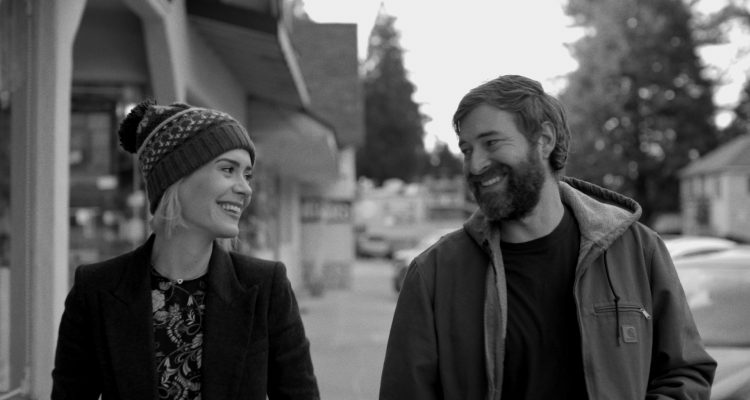Little did Richard Linklater know that over two decades ago, his small-scale romance “Before Sunrise” would not only spark a trilogy, but an entire subgenre of films. The format of two characters coming together for an emotionally connected ramble over a condensed period of time has spawned numerous imitations and inspirations, and this year alone we’ve seen the Barack Obama date movie “Southside With You” and indie “Tramps” loosely follow the template. Now comes “Blue Jay,” another effort that sees two people coming together and lighting a small burning flame between them.
There is nothing cute when Jim (Mark Duplass) and Amanda (Sarah Paulson) run into each other at the grocery store. In fact, Jim seems hesitant about whether or not he should say something, but it’s Amanda who winds up making the first move. They haven’t seen each other since high school, and Jim wishes he had brushed his teeth. It almost seems like he wishes he was anywhere else, and their first encounter ends on an awkward note. However, he quickly recovers his composure, and asks Amanda to join him for a cup of coffee, starting an afternoon of hanging out, which soon fades into the evening.
The former high-school sweethearts are back in their hometown of Crestline, California from the places their lives have since taken them. Amanda is now married, and the step-mother to two children, and is back in town to visit her pregnant sister. Jim works in drywall for his uncle out in Tucson, Arizona but has returned to clean up the house he grew up in and prepare it for a possible sale, following the death of his mother. That alone might explain his fragile state, but there is also another undercurrent of melancholy behind his reunion with Amanda. However, while she may present the picture of someone who has put together, she also’s carrying her own baggage. And behind all of this is the reason they split in the first place, and why they haven’t been in touch all this time.
 Penned by Duplass, “Blue Jay” contains his usual, careful attention to creating characters that feel drawn from real life. Even though the film runs a slim 80 minutes, every minute of that time is spent with Jim and Amanda, and Duplass carefully unravels their histories through conversation, in a manner that feels organic. The closeness the pair once shared doesn’t take long to be rekindled, and it allows an openness that perhaps two strangers might not have in the same situation. However, Duplass winds up cornered by his own premise for the movie; we know that at some point Jim and Amanda will have to broach their split, and that topic becomes the third act reveal, with “Blue Jay” taking a big tonal shift that doesn’t quite work. Until that point, the movie moves with modest delicacy earning potent moments from the smallest of narrative gestures. This changes in the latter stages when bigger plot turns require bigger swings of emotion, and just because scenes are louder or more demonstrative, doesn’t make them more effective. Moreover, the specifics of what led to their breakup feels almost too big for such a small movie, a twist that is much more melodramatic than what the rest of the minor key, breezy picture seemed to be building toward.
Penned by Duplass, “Blue Jay” contains his usual, careful attention to creating characters that feel drawn from real life. Even though the film runs a slim 80 minutes, every minute of that time is spent with Jim and Amanda, and Duplass carefully unravels their histories through conversation, in a manner that feels organic. The closeness the pair once shared doesn’t take long to be rekindled, and it allows an openness that perhaps two strangers might not have in the same situation. However, Duplass winds up cornered by his own premise for the movie; we know that at some point Jim and Amanda will have to broach their split, and that topic becomes the third act reveal, with “Blue Jay” taking a big tonal shift that doesn’t quite work. Until that point, the movie moves with modest delicacy earning potent moments from the smallest of narrative gestures. This changes in the latter stages when bigger plot turns require bigger swings of emotion, and just because scenes are louder or more demonstrative, doesn’t make them more effective. Moreover, the specifics of what led to their breakup feels almost too big for such a small movie, a twist that is much more melodramatic than what the rest of the minor key, breezy picture seemed to be building toward.
Directed by Alex Lehmann, making his feature debut, the aesthetic choice of going black-and-white might seem like nothing more than a novelty. However, the monochrome touch does help in putting the focus on the characters rather than their environment, and also has the effect of dampening some of the sequences which play more broadly than others. But Lehmann’s real imprint isn’t found in the visuals, but in the performances evoked from both Duplass and Paulson. While the former may have the showstopper moments, it’s the latter who stands out. Paulson has never been this naturally relaxed and playful on screen, but she also finds a vulnerability in Amanda that is crucial to the film’s shift. It plays in a different register than Duplass, but one that is arguably more resonant and effective.
“Blue Jay” is ultimately about the lingering intensity of young love, and the longing for the freedom that passion brings when it’s not attached to careers, children, or the worries of middle-age. For just one day, Jim and Amanda return to a time when their love was one of boundless possibility…until it wasn’t. “Blue Jay” finds its greatest truth in that feeling, and while it might not hit all the right notes, the film’s yearning song for that time is convincingly plaintive. [B-]

